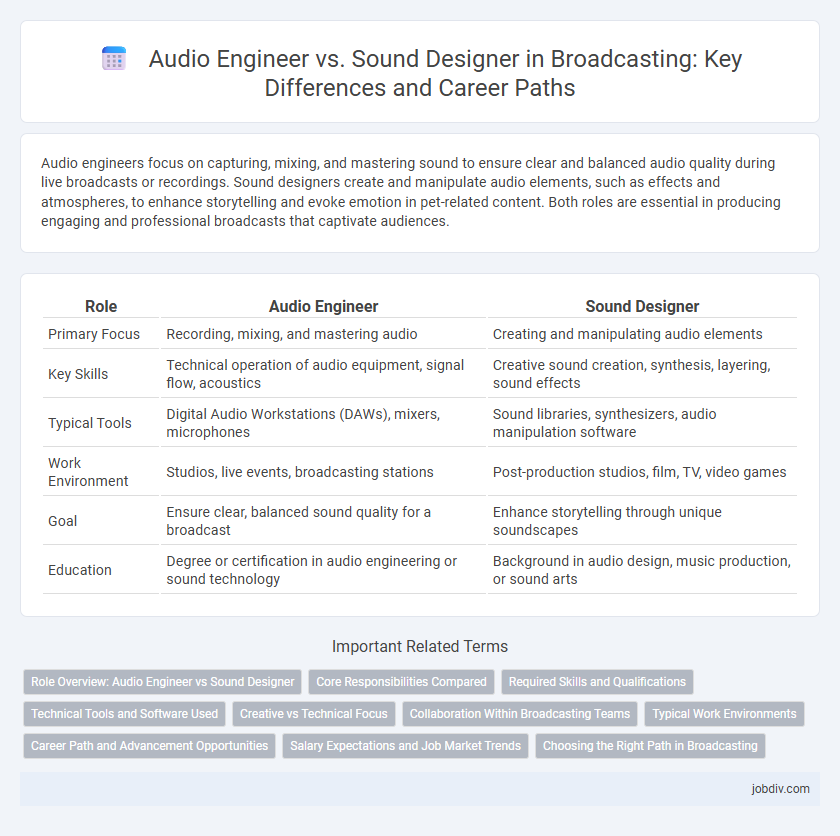Audio engineers focus on capturing, mixing, and mastering sound to ensure clear and balanced audio quality during live broadcasts or recordings. Sound designers create and manipulate audio elements, such as effects and atmospheres, to enhance storytelling and evoke emotion in pet-related content. Both roles are essential in producing engaging and professional broadcasts that captivate audiences.
Table of Comparison
| Role | Audio Engineer | Sound Designer |
|---|---|---|
| Primary Focus | Recording, mixing, and mastering audio | Creating and manipulating audio elements |
| Key Skills | Technical operation of audio equipment, signal flow, acoustics | Creative sound creation, synthesis, layering, sound effects |
| Typical Tools | Digital Audio Workstations (DAWs), mixers, microphones | Sound libraries, synthesizers, audio manipulation software |
| Work Environment | Studios, live events, broadcasting stations | Post-production studios, film, TV, video games |
| Goal | Ensure clear, balanced sound quality for a broadcast | Enhance storytelling through unique soundscapes |
| Education | Degree or certification in audio engineering or sound technology | Background in audio design, music production, or sound arts |
Role Overview: Audio Engineer vs Sound Designer
An audio engineer manages the technical aspects of recording, mixing, and reproducing sound, ensuring clarity and balance in broadcasts. A sound designer creates and manipulates audio elements to enhance the storytelling, often crafting unique soundscapes and effects. Both roles collaborate closely in broadcasting to deliver high-quality audio experiences tailored to the content.
Core Responsibilities Compared
Audio Engineers focus primarily on capturing, mixing, and mastering sound to ensure high-quality audio output for broadcasts, managing equipment and acoustics to prevent technical issues. Sound Designers specialize in creating and manipulating audio elements, crafting unique soundscapes and effects to enhance storytelling and immersive experiences in broadcasting. Both roles require technical expertise, but Audio Engineers emphasize signal clarity and consistency, while Sound Designers prioritize creative sound creation and auditory impact.
Required Skills and Qualifications
Audio engineers require proficiency in operating mixing consoles, microphone techniques, and sound editing software such as Pro Tools or Logic Pro, with a strong understanding of acoustics and signal flow. Sound designers specialize in creating auditory elements using synthesis, sampling, and sound manipulation tools, often possessing skills in Foley artistry and spatial audio design. Both roles typically demand formal education in audio production or engineering, complemented by hands-on experience in recording studios or live sound environments.
Technical Tools and Software Used
Audio engineers primarily utilize mixing consoles, digital audio workstations (DAWs) like Pro Tools and Logic Pro, and signal processors to capture, edit, and optimize sound quality during broadcast production. Sound designers employ software such as Ableton Live, Adobe Audition, and specialized plug-ins for creating and manipulating audio effects, Foley, and immersive soundscapes tailored for storytelling. Both roles demand proficiency with industry-standard tools but differ in technical focus: audio engineers emphasize recording fidelity and live mixing, while sound designers concentrate on creative sound synthesis and post-production enhancement.
Creative vs Technical Focus
Audio engineers specialize in the technical aspects of sound recording and mixing, ensuring clarity, balance, and fidelity in broadcasts. Sound designers emphasize creative sound creation, crafting unique audio elements and effects that enhance the storytelling experience. Their collaboration blends precise technical skills with innovative artistic vision to deliver compelling audio content.
Collaboration Within Broadcasting Teams
Audio engineers and sound designers collaborate closely within broadcasting teams to create high-quality audio content, blending technical precision with creative soundscapes. Audio engineers focus on capturing, mixing, and mastering sound, ensuring clarity and consistency, while sound designers develop unique auditory effects that enhance storytelling. Their collaboration ensures seamless integration of technical sound quality and artistic elements, resulting in immersive and engaging broadcast productions.
Typical Work Environments
Audio engineers typically work in recording studios, live event venues, and broadcast control rooms, handling sound mixing, editing, and equipment setup to ensure optimal audio quality for radio, television, or live audiences. Sound designers are often employed in post-production studios, film sets, and video game development environments, where they create and manipulate audio effects, ambient sounds, and audio textures to enhance narrative and immersive experiences. Both professionals rely heavily on digital audio workstations (DAWs) and specialized software tailored to their respective workflows in the broadcasting industry.
Career Path and Advancement Opportunities
Audio Engineers typically focus on technical aspects like recording, mixing, and mastering, with career paths advancing into senior engineering roles or studio management. Sound Designers emphasize creativity in creating audio effects and environments, often advancing into senior creative roles or lead designer positions within film, games, or broadcasting industries. Both career paths offer opportunities in specialized fields such as live sound, post-production, or interactive media, with continuous skill development critical for advancement.
Salary Expectations and Job Market Trends
Audio engineers typically earn between $45,000 and $75,000 annually, reflecting steady demand in live events and studio settings, while sound designers command higher salaries, often ranging from $60,000 to $90,000 due to specialized skills in film, gaming, and multimedia production. The job market for audio engineers remains stable with consistent opportunities in broadcasting and music industries, whereas sound designers experience rapid growth propelled by expanding digital content creation and immersive media technologies. Emerging trends highlight increased investment in remote sound production and spatial audio design, enhancing prospects for sound designers over traditional audio engineering roles.
Choosing the Right Path in Broadcasting
Audio engineers specialize in capturing and optimizing live and recorded sound through mixing consoles, microphones, and digital audio workstations, focusing on technical precision for broadcasts. Sound designers create and manipulate audio elements like effects, ambiance, and synthesized sounds to shape the auditory experience, often for storytelling and immersive media within broadcasting. Choosing the right path depends on whether your interest lies in technical sound management or creative audio production tailored to broadcast content.
Audio Engineer vs Sound Designer Infographic

 jobdiv.com
jobdiv.com